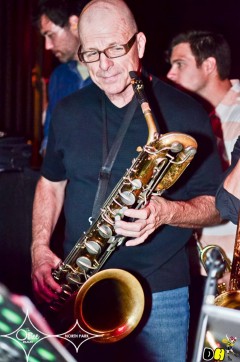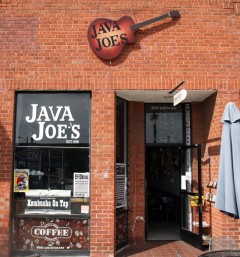Featured Stories
Jazz Jam at Java Joe’s

Dave Good

Java Joe’s on Adams Avenue. Photo by Dennis Andersen.
The story may or may not be true, about how a young alto saxophone player named Charlie Parker got kicked off the bandstand during a 1930s-era club jam session. As the story goes, when compared to the pros at the session on that particular day, Parker was in way over his head, and it showed. The drummer is said to have stopped the noise by throwing a cymbal at his feet. Young Parker (in the story, he was 15 or 16 at the time) left the stage in a fit of humiliation.
But the damage to Parker’s ego was enough to push him into a self-enforced seclusion where he may or may not have invented the term “woodshedding,” which is musician-speak for intensive practicing. But after three years of 13-hour days of shedding in all 12 keys, the Charlie Parker we all know today — as one of the founding fathers of bebop — emerged.
The jazz jam session is a tradition that reaches deep into the lexicon of the music and continues on to this day. As such, jam sessions are loosely organized gigs in which musicians, both jazz and blues players alike, gather to work out on their respective instruments. San Diego hosts a number of first rate jazz jams, for example at 98 Bottles on Sunday afternoons, Mr. Peabody’s in Encinitas on Sunday evenings, at Seven Grand in North Park on Wednesday nights, and at the Rook Bar in La Mesa on Friday nights. Each particular jam session represents a gathering of our hometown’s first-call pro-level level players, the very best of the best that we have to offer in terms of local jazz musicianship, and as a result, the sparks fly.
If you haven’t checked them out yet, I couldn’t encourage you more. For musicians, they are school. And for the rest of us, each of these jams is entertainment of the highest order. But while the jazz jams are open to any and all performers, they are not necessarily conducive to the relative newcomers or intermediate level improvisers among us.
That’s the reason I decided to launch a series of Sunday afternoon jams for those of us who can maybe find our way around a jazz tune, but who aren’t ready to share a microphone with Gilbert Castellanos quite yet. Consider these to be jazz jams for the intermediate level players among us, no matter what instrument. Sax, trumpet, trombone, flute, harmonica, accordion, tuba, clarinet, congas, drums, piano, guitar, bass, cowbell, banjo, whatever you happen make music on.
Jazz singers are more than welcome, too.
Java Joe’s Jazz Jam will be a friendly, slower, mistake-happy environment for new jammers to bring it to the stage and work out. Schedules permitting, I plan to have some of my pro musician friends such as Joe Marillo and Dwight Love and George Kazas drop in from time to time to jam along with us and give pointers to those who want them.
A word now on jam etiquette (which I learned from an old blues guitarist 🙂 time permitting, each instrument will get two songs; jazz tunes can be kind of long when you consider that everybody in the band gets a solo.) I’ll have a sign-up sheet to keep some sense of order about the day. As each player on the list finishes, I’ll call for the next player to come up and work out with the rhythm section, which also may be changing depending on whoever arrives that day. Soloists — be ready with a couple of standards you’ve been working on, stuff out of any of the Real Books, for example, to ensure that whoever is playing rhythm that day knows your songs. That’s how to get the most out of any jam. Know what you want to play and in what key, and have an alternate selection in case no one knows your first choices.
It happens.
The jams at Java Joe’s are free, and are welcome to all ages. And you have my promise: no matter how bad you sound, no one will throw a cymbal at your feet.
Jazz Jam at Java Joe’s, Sunday April 12, 2 — 4pm. (and each Sunday thereafter)
3536 Adams Avenue in Normal Heights. For intermediate level players / all ages / free.






